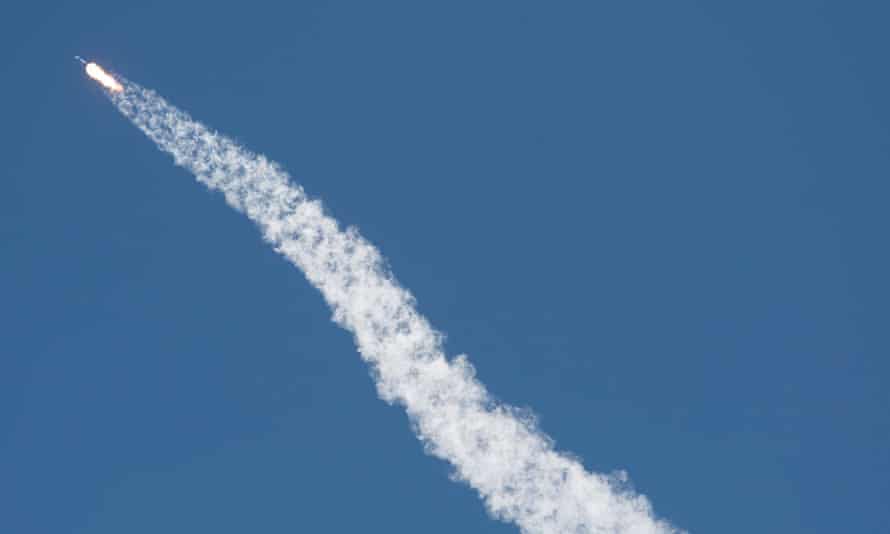A SpaceX rocket ship has blasted off carrying the first all-private astronaut team ever launched to the International Space Station (ISS), a flight hailed by industry executives and Nasa as a milestone in the commercialisation of spaceflight.
The team of four selected by Houston-based startup Axiom Space Inc for its debut spaceflight and orbital science mission lifted off on Friday morning from Cape Canaveral, Florida.
Live video webcast by Axiom showed the 25-storey SpaceX launch vehicle – consisting of a two-stage Falcon 9 rocket topped by its Crew Dragon capsule – streaking into the blue skies over Florida’s Atlantic coast.
Cameras inside the crew compartment beamed footage of the four men strapped into the pressurised cabin, seated calmly in their helmeted white-and-black flight suits as the rocket soared toward space.
Nine minutes after launch, the rocket’s upper stage delivered the crew capsule into its preliminary orbit, according to launch commentators. Meanwhile the rocket’s reusable lower stage, having detached from the rest of the spacecraft, flew itself back to Earth and safely touched down on a landing platform floating on a drone vessel in the Atlantic.
Launch webcast commentator Kate Tice described the liftoff as “absolutely picture-perfect”. One crew member could be heard telling mission control in a radio transmission: “That was a hell of a ride.”
If all goes as planned, the quartet led by the retired Nasa astronaut Michael Lopez-Alegria will arrive at the space station on Saturday, after a 20-hour-plus flight, and the autonomously operated Crew Dragon will dock with the ISS.
SpaceX was directing mission control for the flight from its headquarters near Los Angeles.
Nasa, besides furnishing the launch site, will assume responsibility for the astronauts once they rendezvous with the space station to undertake eight days of science and biomedical research.
The mission, representing a partnership among Axiom, SpaceX and Nasa, has been touted by all three as a major step in the expansion of commercial space ventures collectively referred to by insiders as the low-Earth orbit economy, or LEO economy.
“We’re taking commercial business off the face of the Earth and putting it up in space,” the Nasa chief, Bill Nelson, said before the flight. The shift enabled his agency to focus more on sending humans back to the moon, to Mars and on other deep space exploration, he said.
Friday’s launch also stands as SpaceX’s sixth human space flight in nearly two years, following four Nasa astronaut missions to the space station and the “Inspiration 4” launch in September that sent an all-civilian crew to orbit for the first time. That flight did not dock with the ISS.
While the space station has hosted civilian visitors from time to time, the Ax-1 mission will mark the first all-commercial team of astronauts to use the ISS for its intended purpose as an orbiting research laboratory.
The Axiom team will be sharing the weightless work environment with seven regular, government-paid ISS crew members: three American astronauts, a German and three Russian cosmonauts.
Lopez-Alegria, 63, the Spanish-born Axiom mission commander, is also the company’s vice-president for business development. His second-in-command is Larry Connor, a real estate and technology entrepreneur and aerobatics aviator from Ohio designated as the mission pilot. Connor is in his 70s; the company did not provide his precise age.

Rounding out the Ax-1 team are investor-philanthropist and former Israeli fighter pilot Eytan Stibbe, 64, and Canadian businessman and philanthropist Mark Pathy, 52, both serving as mission specialists. The flight makes Stibbe the second Israeli in space, after Ilan Ramon, who perished with six Nasa crewmates in the 2003 space shuttle Columbia disaster.
The Axiom crew members may appear to have a lot in common with many of the wealthy passengers taking suborbital rides in recent months on board the Blue Origin and Virgin Galactic services offered by billionaires Jeff Bezos and Richard Branson, respectively.
But Axiom said its mission went far beyond space tourism, with each crew member undergoing hundreds of hours of astronaut training with both Nasa and SpaceX.
The Ax-1 team also will be conducting about two dozen science experiments including research on brain health, cardiac stem cells, cancer and ageing, as well as a technology demonstration to produce optics using the surface tension of fluids in microgravity, company executives said.
Launched to orbit in 1998, the space station has been continuously occupied since 2000 under a US-Russian-led partnership including Canada, Japan and 11 European countries.
Nasa has no plans to invest in a new space station once the ISS is retired, around 2030. But Nasa selected Axiom in 2020 to build a new commercial wing to the orbiting laboratory, which is currently the length of a football field.
Plans call for eventually detaching the Axiom modules from the rest of the station when it is ready to be decommissioned. Other private operators are expected to place their own stations in orbit once the ISS is out of service.
In the meantime, Axiom said it has contracted with SpaceX to fly three more private astronaut missions to the space station over the next two years.